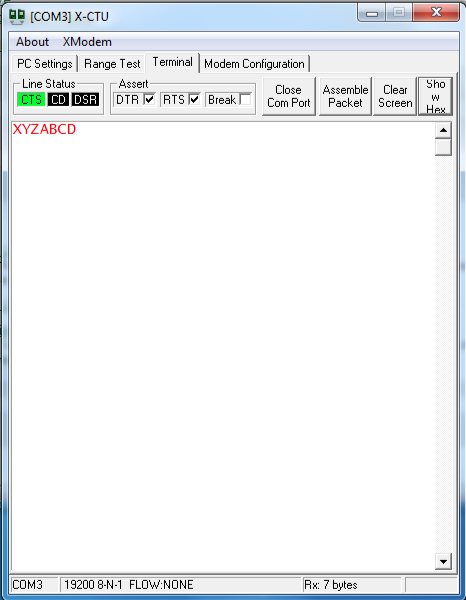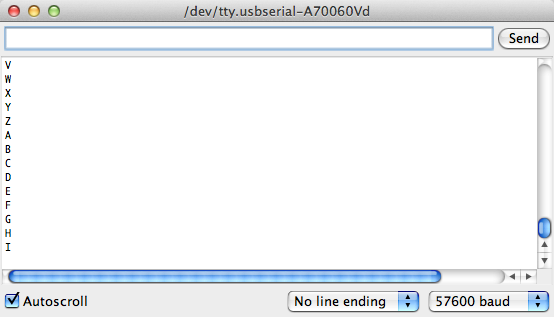Difference between revisions of "Tutorial: Arduino and XBee Communication"
(→It works!) |
(→It works!) |
||
| Line 202: | Line 202: | ||
<br /> | <br /> | ||
| + | <br /> | ||
| + | =Communication with a Mac running OSX= | ||
| + | * If you want to connect the receiving XBee to a Mac instead of a Windows PC, use [http://ashleyhughesarduino.wordpress.com/2010/07/29/xbee-and-macs-the-easy-way/ Ashley Hughes] solution, and read the characters sent by the XBee on the Mac Terminal. | ||
| + | |||
| + | * Connect the XBee via the USB cable to the Mac | ||
| + | * Open the Terminal application | ||
| + | * Enter the following command: | ||
| + | |||
| + | ls /dev/tty.* | ||
| + | |||
| + | :and note the different USB devices listed (of the form /dev/tty.usbserial-######). | ||
| + | |||
| + | * Pick one of the devices and try this: | ||
| + | |||
| + | screen /dev/tty.usbserial-##### 19200 | ||
| + | |||
| + | :If you're lucky, you'll start seeing characters of the alphabet appear on the screen of the Terminal window, one a second, going through the whole alphabet. | ||
<br /> | <br /> | ||
Revision as of 12:05, 12 April 2012
--D. Thiebaut 17:47, 9 April 2012 (EDT)
This page shows how to quickly test the connection and good operating conditions of two XBee modules.
Contents
Setup
The setup is simple:
- Windows PC <---USB-cable---> Xbee (receiver) <--wireless--> XBee (Xmitter) <---> Arduino
- Instead of a pure Windows machine, we're using a MacPro running Windows in Parallels. This is our Windows machine.
- Windows is connected to an XBee via a USB cable.
- Windows run the X-CTU software that interacts with the XBee. This XBee is in receiving mode.
- An Arduino is connected to the MacPro. The Arduino is connected via 4 wires to another XBee module. This XBee module works in transmit mode.
- The Arduino sends a character of the alphabet to the XBee every second. First 'A', then 'B', all the way to 'Z', then 'A' again, ad infinitum.
Testing XBees on the Windows PC
- Note: The 2 XBee modules are purchased from ADAFruit.com
- Testing steps:
- Downloaded X-CTU software from ladyada.net
- X-CTU upgraded itself once started
- Followed the directions from the configure page at ladyada.net
- Module #1:(marked with "1" in silver marker on square near antenna)
Communication with modem. OK Modem type = XB24 Modem firmware version = 10EC Serial Number = 13A2004078E552
- Following steps from the configure page, reset the baud rate to 19200, and upgraded to most recent firmware.
- Module #2:(marked with "2" in silver marker on square near antenna)
Communication with modem. OK Modem type = XB24 Modem firmware version = 10EC Serial Number = 13A2004078E642
- Following steps from the configure page, reset the baud rate to 19200, and upgraded Module 2 to most recent firmware.
Testing Arduino
- Install Arduino IDE on 2nd computer (a MacPro)
- Launch Arduino app IDE
- Connect Arduino board to MacPro via USB cable.
- Use the Tools menu to set the model to Diecimila and the USB port to the appropriate port.
- To test normal operation, open the Blink program from the examples (available via the File menu):
/*
Blink
Turns on an LED on for one second, then off for one second, repeatedly.
This example code is in the public domain.
*/
void setup() {
// initialize the digital pin as an output.
// Pin 13 has an LED connected on most Arduino boards:
pinMode(13, OUTPUT);
}
void loop() {
digitalWrite(13, HIGH); // set the LED on
delay(1000); // wait for a second
digitalWrite(13, LOW); // set the LED off
delay(1000); // wait for a second
}
- Upload to Arduino
- Verify that the LED blinks.
Connection of Arduino to XBee
Hardware
- Very simple connections from Arduino to XBee with 4 wires:
| Arduino | <---> | XBee |
|---|---|---|
|
+5V |
<---> |
+5V |
|
GND |
<---> |
GND |
|
Digital Pin 2 |
<---> |
TxD |
|
Digital Pin 3 |
<---> |
RxD |
Software
- Use the Arduino SoftwareSerial page on the SoftwareSerial library. Great reference for figuring out how Arduino can talk to XBee via a serial port.
- Created Arduino program in IDE:
/*
Xbee1
D. Thiebaut
Makes Arduino send 1 character via XBee wireless to another XBee connected
to a computer via a USB cable.
The circuit:
* RX is digital pin 2 (connect to TX of XBee)
* TX is digital pin 3 (connect to RX of XBee)
Based on a sketch created back in the mists of time by Tom Igoe
itself based on Mikal Hart's example
*/
#include <SoftwareSerial.h>
SoftwareSerial xbee(2, 3); // RX, TX
char c = 'A';
int pingPong = 1;
void setup() {
Serial.begin(57600);
Serial.println( "Arduino started sending bytes via XBee" );
// set the data rate for the SoftwareSerial port
xbee.begin( 19200 );
}
void loop() {
// send character via XBee to other XBee connected to Mac
// via USB cable
xbee.print( c );
//--- display the character just sent on console ---
Serial.println( c );
//--- get the next letter in the alphabet, and reset to ---
//--- 'A' once we have reached 'Z'.
c = c + 1;
if ( c>'Z' )
c = 'A';
//--- switch LED on Arduino board every character sent---
if ( pingPong == 0 )
digitalWrite(13, LOW);
else
digitalWrite(13, HIGH);
pingPong = 1 - pingPong;
delay( 1000 );
}
- Compiled program.
- Uploaded program to Arduino.
- In Windows use X-CTU software and click on Terminal Tab to monitor data received wirelessly from Arduino.

- On Arduino side, in IDE, uses Tools menu and opened the console window to see Arduino print characters as they are sent:

It works!
- Observe video. Notice the characters of the alphabet appearing once a second in both windows. One is the console, attached to the transmitting Arduino, the other one is the Terminal window of the X-CTU software on the Windows side, receiving the characters sent wirelessly.
Communication with a Mac running OSX
- If you want to connect the receiving XBee to a Mac instead of a Windows PC, use Ashley Hughes solution, and read the characters sent by the XBee on the Mac Terminal.
- Connect the XBee via the USB cable to the Mac
- Open the Terminal application
- Enter the following command:
ls /dev/tty.*
- and note the different USB devices listed (of the form /dev/tty.usbserial-######).
- Pick one of the devices and try this:
screen /dev/tty.usbserial-##### 19200
- If you're lucky, you'll start seeing characters of the alphabet appear on the screen of the Terminal window, one a second, going through the whole alphabet.